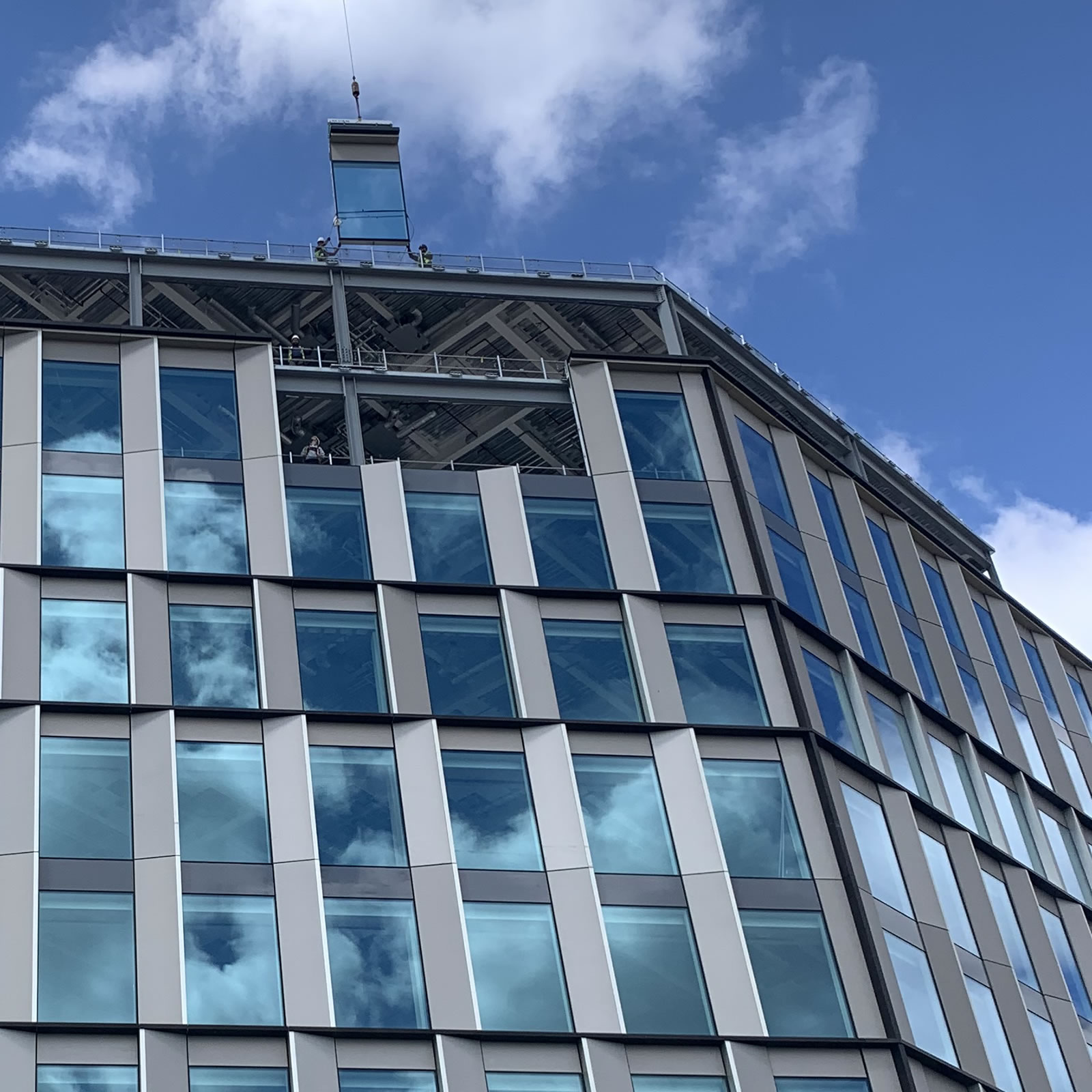Curtain wall or traditional cladding: which serves a commercial building better? It’s a question more developers are asking as UK building regulations tighten. What once was a matter of appearance is now closely tied to performance: air tightness, weather resistance, environmental efficiency, and so on. Curtain walls offer a lightweight, external skin that doesn’t load the structure, but still has to deal with the pressure of wind, rain, solar gain and building movement.
Traditional facades, on the other hand, tend to rely on heavier materials like brick, stone or timber – materials long trusted but often slower to build with (and harder to insulate). Today, Pops Facades will weigh the practical differences and performance outcomes so that you can decide what makes the most sense for your next project.
What is a curtain wall?
A curtain wall is a lightweight, self-supporting system typically made of glass and metal that is installed on the outside of a building without carrying any of its structural load. Its main functions are to resist environmental forces: its transparent appearance can also give buildings a more ‘modernist’ feel, aesthetically. They’re a popular choice for high-rise buildings, office towers, hotels, and contemporary commercial projects. Curtain walls can be made using glass and aluminium, but plastic and hybrid combinations with wood or other metals are also common.
Pros
- Visual & architectural appeal: Curtain walls are often the go-to choice for modern buildings. With customisable designs, including curved and multi-faceted configurations, curtain walls allow for greater architectural creativity.
- Lightweight & non-structural: A curtain wall is a lightweight, self-supporting system that hangs on the outside of a building without carrying any of its structural load.
They don’t need to be installed on the building’s foundations, as they support their own weight. As such, if they’re damaged or experiencing complications, curtain walls are far less likely to affect the main building structure they protect.
- Energy performance & weather‑resistance: Curtain walls integrate high-performance glazing and insulation technologies to improve thermal efficiency and reduce energy consumption.
They often feature double-glazed and Low-E Glass coatings to minimise heat loss in winter. Their airtight sealing systems can also prevent air leaks, moisture infiltration, and condensation issues.
- Adaptable to movement: Curtain walls are designed to absorb sway caused by wind, divert water from rain, and withstand even seismic activity.
The perimeter joint/movement gap/firestop zone, which accommodates building movement, is crucial for both fire protection and preventing flanking sound transmission.
- Design flexibility: As we mentioned earlier, curtain walls can have customisable designs, including curved and multi-faceted configurations. In fact, parametric and generative design are changing how architects shape facades.
These new algorithms mean that now, architects can design complex curtain wall shapes that respond to environmental factors like sunlight and airflow.
Cons
- Installation challenges: A curtain walling system cannot be installed by just anyone; it requires professionals who specialise in the process. They demand more planning, skilled labourers and careful installation.
- Maintenance & repairs: Curtain walls typically demand more periodic washing. They are large, glass surfaces that require routine glass cleaning and periodic inspections to maintain their performance.
- Thermal bridging & solar gain: If lighting and shading controls are not properly managed, transparent facades can lead to higher heating and cooling demand.
What is a traditional facade?
A traditional facade is the outside face or exterior surface of a building. The building of a facade can be done via traditional forms of architecture, where conventional materials such as brick, stone and timber are often used. Such an approach is generally achieved through cladding, which is a protective or decorative layer applied directly to the building’s structure.
Pros
- Aesthetic appeal: Cladding materials may include metal, wood, brick, stone, composite, and vinyl. Architects use these materials to modify a building’s aesthetic to blend in with older or more traditional structures.
Simple construction: Cladding is typically faster to install, especially for renovations. It’s a popular structure choice when upgrading homes and older properties.
(Though it is important to understand that installation times will vary. Each building’s foundation must bear the weight of cladding, so it could result in greater construction costs if not properly assessed.)
- Lower maintenance: Cladding systems typically demand less maintenance compared to curtain walls, although the specific requirements can vary based on the materials used (e.g., metal, wood, composite).
Cons
- Less cost-effective: Although traditional construction methods were historically cost-effective (due to the wide availability of materials and a large pool of trained builders), this pool has severely dissipated.
Traditional construction heavily relies on skilled labour, and this can contribute to higher costs. Plus, traditional facades often result in higher annual operational costs for heating, cooling, and lighting.
- Speed of construction: Traditional construction tends to be time-intensive, relying on sequential processes; this can result in longer project timelines.
- Environmental impact: When compared to modern transparent facades with advanced controls, traditional brick facades with smaller punched windows can result in higher total site energy consumption in certain scenarios (e.g., heating-dominated climates).
Do you need cladding installation and replacement?
Ultimately, when it comes to modern commercial builds, the choice between curtain walling and traditional facades can have a major impact on appearance and performance. Curtain wall systems have the edge where thermal efficiency, aesthetics and structural benefits are concerned – but only when installed by a team with proven expertise.
At Pops Facades, we specialise in unitised curtain wall installation that meets today’s performance demands (and tomorrow’s regulatory standards). With over 15 years of experience undertaking unitised curtain wall projects, we bring installation knowledge that supports both refurbishment and new‑build developments. So, if you’re a building owner or overseeing a commercial development, trust us to manage the full process. To inquire or for more information, contact us.
